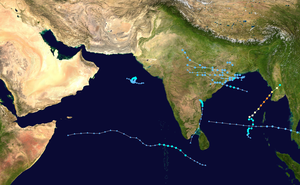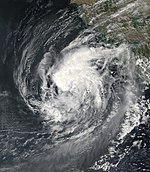2006 North Indian Ocean cyclone season
| 2006 North Indian Ocean cyclone season | |
|---|---|

Season summary map
|
|
| Seasonal boundaries | |
| First system formed | January 13, 2006 |
| Last system dissipated | October 30, 2006 (Officially) December 7, 2006 (Unofficially) |
| Strongest storm | |
| Name | Mala |
| • Maximum winds | 185 km/h (115 mph) (3-minute sustained) |
| • Lowest pressure | 954 hPa (mbar) |
| Seasonal statistics | |
| Depressions | 12 official, 1 unofficial |
| Deep depressions | 6 |
| Cyclonic storms | 3 |
| Severe cyclonic storms | 2 |
| Very severe cyclonic storms | 1 |
| Total fatalities | 623 |
| Total damage | At least $6.7 million (2006 USD) |
| Related articles | |
| Deep depression (IMD) | |
| Tropical storm (SSHWS) | |
| Duration | January 13 – January 14 |
|---|---|
| Peak intensity | 55 km/h (35 mph) (3-min) 1004 hPa (mbar) |
| Extremely severe cyclonic storm (IMD) | |
| Category 4 tropical cyclone (SSHWS) | |
| Duration | April 25 – April 29 |
|---|---|
| Peak intensity | 185 km/h (115 mph) (3-min) 954 hPa (mbar) |
| Deep depression (IMD) | |
| Tropical storm (SSHWS) | |
| Duration | July 2 – July 5 |
|---|---|
| Peak intensity | 55 km/h (35 mph) (3-min) 982 hPa (mbar) |
| Depression (IMD) | |
| Duration | September 3 – September 4 |
|---|---|
| Peak intensity | 45 km/h (30 mph) (3-min) 992 hPa (mbar) |
| Depression (IMD) | |
| Duration | September 21 – September 24 |
|---|---|
| Peak intensity | 45 km/h (30 mph) (3-min) 996 hPa (mbar) |
| Severe cyclonic storm (IMD) | |
| Tropical storm (SSHWS) | |
| Duration | September 21 – September 24 |
|---|---|
| Peak intensity | 100 km/h (65 mph) (3-min) 988 hPa (mbar) |
| Depression (IMD) | |
| Tropical storm (SSHWS) | |
| Duration | September 28 – September 30 |
|---|---|
| Peak intensity | 45 km/h (30 mph) (3-min) 1002 hPa (mbar) |
| Cyclonic storm (IMD) | |
| Tropical storm (SSHWS) | |
| Duration | October 29 – October 30 |
|---|---|
| Peak intensity | 65 km/h (40 mph) (3-min) 988 hPa (mbar) |
The 2006 North Indian Ocean cyclone season had no bounds, but cyclones tend to form between April and December, with peaks in May and November. These dates conventionally delimit the period of each year when most tropical cyclones form in the northern Indian Ocean.
The scope of this basin is north of the Equator and west of the Malay Peninsula. The IMD and JTWC monitor this basin. This basin is divided in two seas by India, the Bay of Bengal and Arabian Sea, abbreviated BOB and ARB, respectively.
Although an inactive year, 2006 had more of note than previous years like 2005 or 2004. Cyclone Mala caused severe damage and killed 22 when it hit Burma as a cat. 3. An unnamed depression killed over 100 in India, and cyclonic storm Ogni caused minor effects in India as well. Additionally, the remnants of Typhoon Durian crossed the Malay Peninsula causing minor effects, but was a rare basin-crosser in this area.
Overall activity across the North Indian Ocean during 2006 was slightly below-average, with 12 depressions, 3 cyclonic storms, and 1 very severe cyclonic storm. An average season, according to the IMD, consists of 15 depressions and 5–6 cyclonic storms. In addition to the storms monitored by the IMD, the JTWC also tracked the remnants of Typhoon Durian across the Malay Peninsula into the Andaman Sea as a tropical depression in early December. The majority of storms formed within the Bay of Bengal, with only two existing in the Arabian Sea. Activity peaked during the summer due to an active southwest monsoon.
Starting in May, the seasonal monsoon developed over the Bay of Bengal and advanced northwestward over India where it propagated through September. During this period the system spawned numerous disturbances, nine of which became tropical cyclones. All but one of these systems formed in the northern Bay of Bengal and struck Odisha before spreading rain across large portions of India. The outlier was Severe Cyclonic Storm Mukda in late September which remained virtually stationary its entire existence to the southwest of Gujarat. The combined effects of the eight other depressions along with the monsoon itself caused disastrous flooding throughout India. By early August, nearly 500,000 people were evacuated in Mumbai due to rising waters. The collective effects of the depressions alone resulted in at least 562 fatalities with hundreds more attributed to the monsoon rains. More than 1 million people across Odisha were left homeless from the storms.
...
Wikipedia













